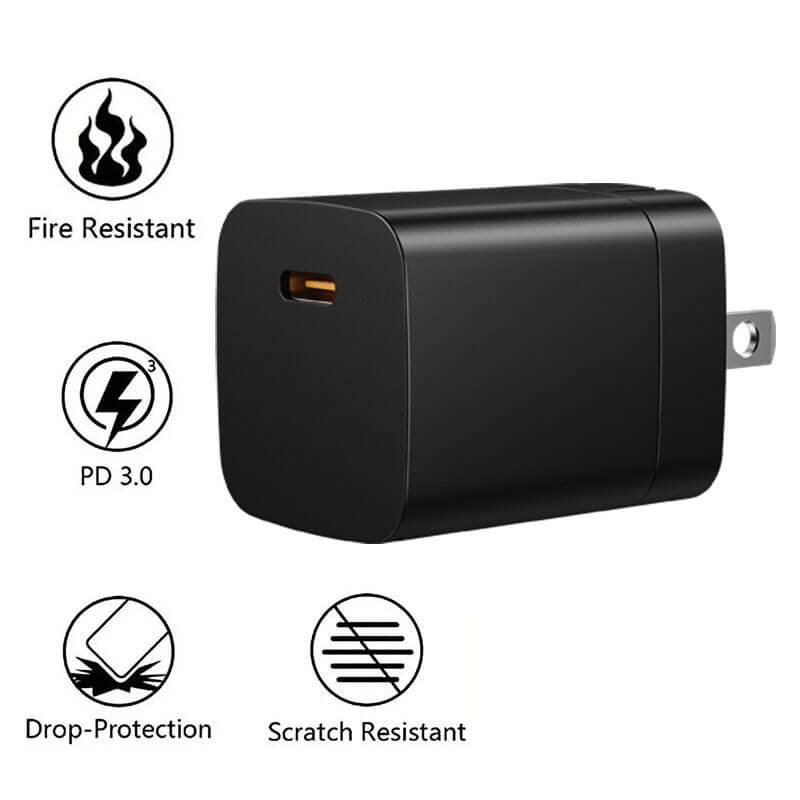Small Charger Revolution: Balancing Compact Design & High Performance
Modern people's demand for "Travel light" has never been so urgent. When business travelers' backpacks are filled with laptops, tablets, cameras and tripods, the space occupied by a traditional charger is enough to drive people crazy. But now, a gallium nitride charger that is smaller than a lipstick can achieve all-weather fast power supply in the size of half a palm - this "space liberation movement" driven by technological innovation is redefining our way of travel.
1. From "brick" to "lipstick": A brief history of the evolution of chargers
Twenty years ago, laptop chargers were still "black bricks" weighing 500 grams, and mobile phone chargers also generally had problems with severe heating and slow charging. Although the 5W charger launched by Apple in 2010 was smaller in size, it was gradually unable to keep up with the current situation where the battery capacity of smartphones jumped from 1500mAh to 5000mAh.

The turning point came in 2018, when the first batch of gallium nitride (GaN) chargers were officially commercialized. This new semiconductor material allows engineers to reduce the volume of the charger by 40% while maintaining a high power output of 65W. Take IDEAL's mini charger as an example:
- The size is 43% smaller than traditional chargers, only half the size of a palm

- The weight is controlled at 38 grams, equivalent to 7 1 yuan coins

- The surface temperature is 8-12℃ lower than that of ordinary chargers, and the safety is significantly improved
This revolution is not simply the pursuit of "small", but a technological breakthrough of "small and strong" through material innovation.
2. Decoding Gallium Nitride: The "Black Technology" That Makes Chargers Magic
Gallium nitride (GaN) is known as the third-generation semiconductor material, and its electron mobility is 1,000 times that of traditional silicon materials. Simply put, it's like upgrading a country road to an eight-lane highway, and the current flow efficiency has a qualitative leap:
Energy loss is reduced by 30%: Traditional silicon devices "waste" 15-20% of energy when converting electricity, while GaN can control the loss to less than 5%
Switching frequency is increased by 10 times: This allows the size of components such as transformers to be greatly reduced
High temperature resistance: GaN devices can still work stably in an environment of 200°C, avoiding safety hazards caused by overheating

A laboratory test shows that a 20W charger using GaN technology can charge an iPhone 14 to 60% in 30 minutes, and the temperature is always below 41°C throughout the process. This "calm explosive power" is the core code for mini chargers to balance performance and safety.
3. Business travel scene adaptation: Redefining "light travel"
For business people who travel frequently, the pain points of charging equipment are particularly obvious:
1. Weight anxiety: International business trips usually require carrying multiple device chargers such as laptops, mobile phones, and tablets, and the total weight of the traditional combination exceeds 800 grams
2. Space war: The number of hotel sockets is limited, and using multiple chargers at the same time requires "stacking" operation
3. Compatibility dilemma: Differences in voltage standards in different countries cause chargers to "not adapt to the local environment"
A ultra-mini GaN charger with a multi-port charging cable can:
Power mobile phones, headphones, and smart watches at the same time
Automatically adapt to 100-240V global voltage
Folding pin design to avoid scratching other luggage

Actual data shows that after business travel users switch to mini chargers, the utilization rate of backpack space increases by 17%, and the efficiency of device charging management increases by 40%. An airline even began to purchase mini chargers as business class gifts-this detail reflects the rigid demand for extreme portability in mobile office scenes.
4. Performance without compromise: Small size, great wisdom
Some people question: Does the reduction in size mean performance castration? In fact, engineers have achieved "concentrated essence" through three major innovations:

1.Three-dimensional stacking technology
Changing the circuit board from a flat layout to a three-dimensional structure is similar to converting a bungalow into a skyscraper. A certain brand has integrated 132 components in 1 cubic inch of space by stacking 7 layers of PCB.
2. Intelligent temperature control system
The built-in temperature sensor will adjust the output power in real time. When the ambient temperature exceeds 45℃, it will automatically start overheating protection, which is 3 times faster than the reaction speed of traditional chargers.
3. Adaptive protocol matrix
Supports 18 fast charging protocols such as PD3.0 and QC4.0, and can automatically identify connected devices and match the best charging solution. For example, when charging the Switch game console, it will prioritize maintaining a stable voltage of 15V; when connecting AirPods, it will switch to 5V trickle mode.
5. Future Trends: When the Charger Becomes an "Invisible Butler"
Miniaturization is just the starting point, and charging equipment is evolving towards intelligence:
Wireless integration: A laboratory has demonstrated a wireless charging module the size of a stamp, which can be embedded in a luggage compartment or a hotel headboard
Energy Management Center: Connect to the mobile phone APP via Bluetooth to display the power consumption statistics and energy efficiency analysis of each interface in real time
Emergency Power Supply Mode: In the event of a sudden power outage, the smart charger can call on the 5Wh backup power stored in the built-in capacitor to support the mobile phone to complete an emergency call
What is more worth looking forward to is the breakthrough in photovoltaic charging technology. The solar GaN charger being developed by a startup company can replenish electricity autonomously under sunlight conditions - this means true "freedom of electricity use" for outdoor workers and adventure enthusiasts.
6. A productivity revolution hidden in your pocket
When we gently put a mini charger into our shirt pocket, we take away not only a few cubic centimeters of physical space, but also the psychological freedom of breaking free from the constraints of wires. This miniaturization revolution driven by material science proves that the essence of technological evolution is never simply to "add", but to create the possibility of a smoother life for human beings in a more elegant way. Next time when we pack for a business trip, maybe we can take one less charger and one more inspiration to change the world.




